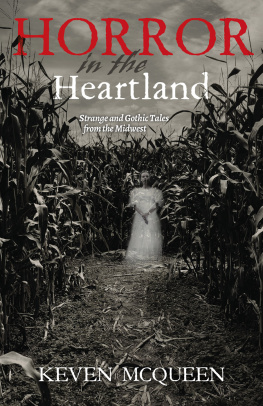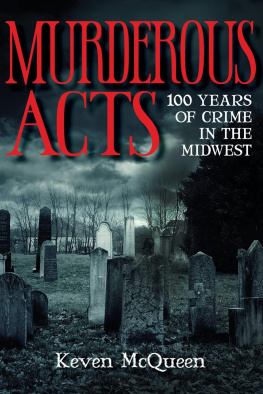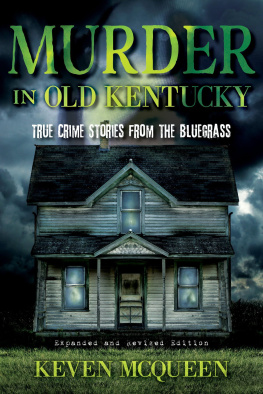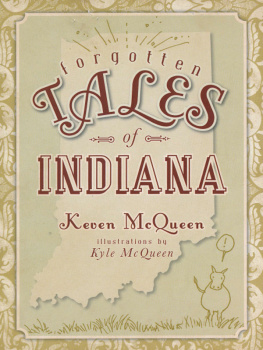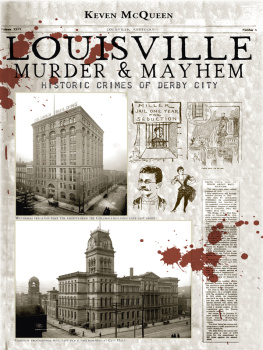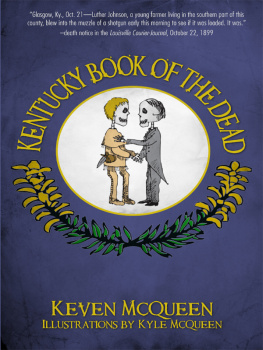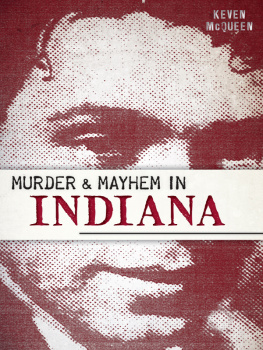
Published by The History Press
Charleston, SC 29403
www.historypress.net
Copyright 2009 by Keven McQueen
All rights reserved
Illustrations by Kyle McQueen
First published 2009
ebook edition 2012
ISBN 978.1.61423.434.0
Library of Congress Cataloging-in-Publication Data
McQueen, Keven.
Strange tales of crime and murder in southern Indiana / Keven McQueen.
p. cm.
print edition ISBN 978-1-59629-772-2
1. Murder--Indiana--History. 2. Murder--Indiana--Case studies. I. Title.
HV6533.I6M37 2009
364.15230977209034--dc22
2009035772
Notice: The information in this book is true and complete to the best of our knowledge. It is offered without guarantee on the part of the author or The History Press. The author and The History Press disclaim all liability in connection with the use of this book.
All rights reserved. No part of this book may be reproduced or transmitted in any form whatsoever without prior written permission from the publisher except in the case of brief quotations embodied in critical articles and reviews.
Dedicated to my nephew, Evan.
CONTENTS
WITHOUT WHOM, IT WOULD NOT HAVE BEEN POSSIBLE
Geneta Chumley, Sandee Clemons, Drema Colangelo, Eastern Kentucky University Department of English and Theatre, Eastern Kentucky University Interlibrary Loan Department, Lee Feathers, Julie Foster, Rosie Garcia-Grimm, Ken Grimm, Kyle and Bonnie McQueen, the Darrell McQueen family, Pat New, Gaile Sheppard, Jonathan Simcosky, Mia Temple, Carol Thomas, Ashley Wray and everyone at The History Press. Also: Providence (not the city).
This book was edited by Lee Feathers of the Green Pine editorial services. www.greenpineeditorial.com.

INTRODUCTION
The study of murder, said true crime author Edmund Pearson, is the study of the human heart in its darkest, strangest moments. Prepare to take a tour of some dark, strange moments. This book includes nine stories of murders that occurred in southern Indiana nearly, or over, a century ago.
Despite our innate need to romanticize the Good Old Days, a perusal of these historical murders will demonstrate that people always have been ready to raise the hatchet or poison the medicine when it seemed in their best interests to do so. Whenever a murder occurs, there is always the question of motive: why did one human decide to deprive another of the right to life? Sometimes the motives of these Hoosier killers from long ago at least are understandable: Mrs. Armstrong wanted her dreary old husband out of the way so she could collect his insurance and gad about with a younger man; Jim Gillespie shot his hated sister because he felt she had been unfairly favored; young Bill Benson wanted to marry so badly that he was willing to remove by violence the people he perceived as blocking his path to matrimonial happiness. The motives in other cases are downright trivial: James Stone murdered an entire family just to get money to pay off farming equipment; Mr. Thurman foolishly shot a stranger in a case of mistaken identity; William Artmann stomped his wife to death because she wouldnt stop singing an irritating song. In still other cases, motives are completely indiscernible: Mrs. Winstandley murdered because she was a lunatic, and who can say why an apparent serial killer strangled women in Evansville at the turn of the century?
If the purposes of these antique crimes sometimes seem strangely modern, so do the punishments the perpetrators receivedor, perhaps it is more accurate to say, the lack of appropriate punishments. Finding clever ways to avoid taking your lumps after committing a murder is nothing new. Only one tale recounted herein ends with a hanging. In two other cases, lucky murderers got the death sentence but were reprieved (one later committed a second murder); in another case, a man was convicted of murder but released on a technicality; the murderer in the chapter A Petrifaction was never punished because he was never caught; Wilbur Sherwell likely was a serial killer but was acquitted due to lack of evidence and a poorly presented prosecution; and as recounted in the final chapter, the poisoner, Mrs. Armstrong, got a lesser punishment thanks to a softhearted jury. The reader will also observe that murderers who are perfectly sound of mind often trot out the insanity defense in these pages, just like their modern counterparts.
It is only too likely that, one hundred years from now, true crime books concerning murders dating from the early twenty-first century will be full of the same motives and the same dodges.
BENSONS BUTCHERY
One thing everybody agreed upon: Jacob Mottweiler could not have chosen a more isolated location in Indiana in which to live. Specifically, the Mottweiler farm was located in a valley surrounded by almost inaccessible hillsaccording to a chronicler of the dark deed that unfolded theretwo miles from Edwardsville, two miles from the highway and a full mile from the nearest neighbor. A perfect setting for a murder, one might say.
Mottweiler settled there in the 1860s, just after the Civil War. In this lonesome place he chose to call home, he dwelled with his wife, Mary Ellen, and Sallie Snyder. The Mottweilers were a childless couple and had adopted blonde-haired, blue-eyed Sallie, Mrs. Mottweilers orphaned little sister. She earned her keep by doing domestic chores, but unfortunately for all concerned, she would turn out to be something of a floozyif not the town floozy, then at least a hilltop floozy. In the delicate phrasing of a newspaper report, she had a very bad reputation for chastity.
All was invigorating hard work and bucolic pleasures until June 1888, when the Mottweilers took in a sickly, malnourished, illiterate, homeless and friendless eighteen-year-old boy who was living at the county poorhouse. His name was William Benson, and he was so poorly educated and ignorant that he did not even know the name of the county in which he resided. The Mottweilers fed him and nursed him back to health, whereupon he remained at their house as a farmhand. It was one of the farming couples pet projects to see that Benson got an education. Benson was well liked by the neighborswhat little they saw of himand seemed to get along well with his benefactors.
But there was something the Mottweilers did not know: their charge, Benson, had fallen madly in loveor, at least, in lustwith Sallie Snyder. He did everything he could think of to get her to marry him, which was generous on his part since she was very, very pregnant and he wasnt the father. He promised to provide for the offspring of her shame, but Sallie refused each time he offered. She did not love him, she said, and she did not want to leave the comfortable home made for her by her sister and brother-in-law.
On Sunday, December 9, 1888, Benson told Mr. Mottweiler of his hearts burning desire to marry Sallie Snyder; he asked if the farmer would let Benson live in a cottage on the farm if he could persuade her to tie the knot. I would do almost anything for you, said Mottweiler. But I cannot afford to build a house for you since the fruit crop failed last summer. Despite all the good things the generous Mottweiler had done for him, Benson did not take well to this thwarting of his fondest dreams. It appears that this was the catalyst for the violence that followed. The farmhand brooded over his ill fortune until, somehow, a very poorly thought out and deeply ungrateful plan formed in his mind: if the Mottweilers were dead, Sallie would have little choice but to tie her fortune to his because then she would be homeless and what other man would have her? Benson convinced himself that if the farmer and his wife met with an untimely death, he could legally take possession of the land. Before the day was finished, Benson had made a fateful, foolish decision.




